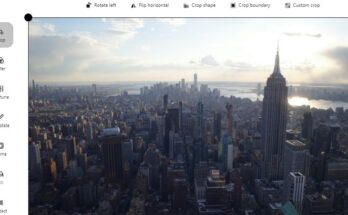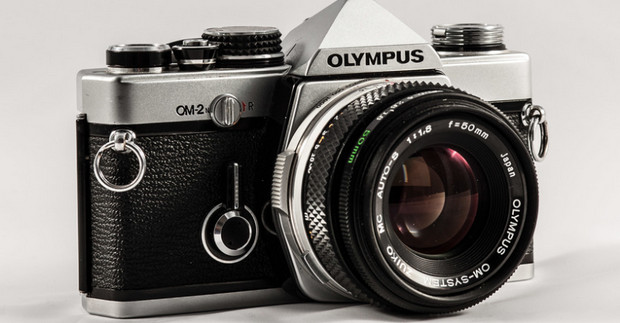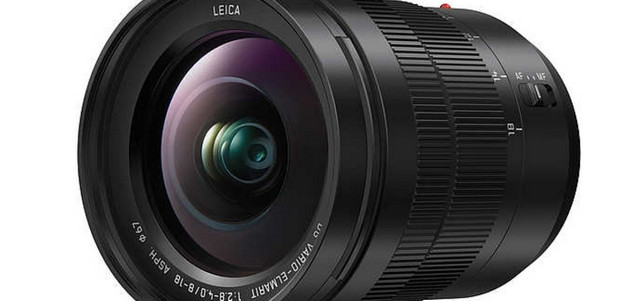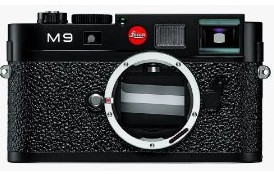 Like the sight of a luxury liner steaming out of a dock, or a private jet drawing white trails across a perfect blue sky, Leica cameras are something we’re only likely to experience from a substantial distance.
Like the sight of a luxury liner steaming out of a dock, or a private jet drawing white trails across a perfect blue sky, Leica cameras are something we’re only likely to experience from a substantial distance.
With their stratospheric price tags, Leica cameras remain the playthings of the well-heeled and deep pocketed professionals, and their latest M9 digital rangefinder camera continues the trend.
Barely troubling itself to consider the fact that it’s been born into a recession, the new Leica M9 18MP Digital Range Finder Camera is asking nay demanding, a pre-order price of $6,995 on Amazon. And that’s for the body-only.
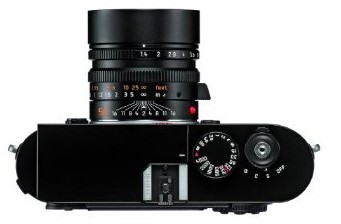 Naturally, it looks stunning.
Naturally, it looks stunning.
With its compact dimensions of only 139 x 37 x 80 mm (5.47 x 1.45 x 3.15 inches), the Leica can claim to be the world’s smallest full-format digital system camera, sporting a specially developed 18-megapixel CCD sensor from Kodak, allowing the full 35mm format to be achieved.
The viewfinder/rangefinder system uses ‘available light’ exposures and discreet portraiture, with a new, microprocessor-controlled, super quiet, metal-leaf, focal-plane shutter serving up shutter speeds of up to 1/4000 seconds.
The M9 takes SD cards up to 2 GB, SDHC cards up to 32 GB.
You only have to look at it to know it’s going to be the best camera you’ve ever owned, but most probably the only time you’ll be snapping the streets with this baby around your neck is when you’re tucked up in bed and dreaming sweet dreams.
*sigh.
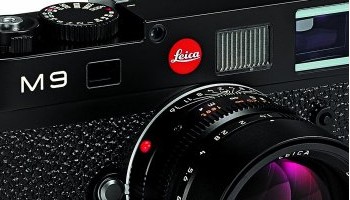 Specifications:
Specifications:
Camera type
Compact digital view and rangefinder system camera.
Lens attachment
Leica M bayonet with additional sensor for 6-bit coding.
Lens system
Leica M lenses from 16 to 135 mm.
Picture format/Image sensor
5270 x 3516 pixels (18.5 Megapixel) CCD chip, active area approx. 23.9 x 35.8 mm 5212 x 3472 pixels (18 Megapixel) (corresponding to usable format of analog Leica M models).
Resolution
Adjustable, DNG™: 5212 x 3472 pixels (18 Megapixel), JPEG: 5212 x 3472 (18 Megapixel), 3840 x 2592 (10 Megapixel), 2592 x 1728 (4,5 Megapixel), 1728 x 1152 (2 Megapixel), 1280 x 846 pixels (1 Megapixel).
Data formats
DNG (raw data), choice of uncompressed or slightly compressed (by non-linear reduction of color depth), 2 JPEG compression levels.
File size
DNG: 18 MB (compressed)/36 MB (uncompressed), JPEG: approx. 2–10 MB.
Color spaces
Adobe® RGB, sRGB.
White balance
Automatic, manual, 7 presets, color temperature selection.
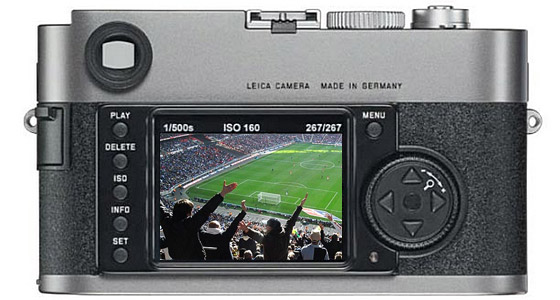
Storage medium
SD cards up to 2GB/SDHC cards up to 32GB.
Menu languages
German, English, French, Spanish, Italian, Japanese, Traditional Chinese, Simplified Chinese, Russian.
Compatibility
Windows® XP/Vista®; Mac® OS X (10.5).
Exposure metering
Exposure metering through the lens (TTL), center-weighted with working aperture. Center-weighted TTL metering for flash exposure with system-compatible SCA-3000/2 standard flash units.
Measurement principle
Measured by light reflected by bright shutter blades on the first shutter curtain.
Metering range
(at ISO 160/23°) At room temperature and normal humidity corresponds to EV 0 to 20 or f/1.0 and 1.2 s to f/32 and 1/1000s. Flashing left triangular LED in viewfinder indicates values below metering range.
Measurement cell for available light
(continuous light measurement) Silicon photo diode with condensing lens, positioned in the bottom center of the camera base.
Sensitivity range
ISO 80/19° to ISO 2500/35°, adjustable in 1/3 ISO increments, with aperture priority A and manual exposure setting, choice of automatic control or manual setting, automatic control with snapshot profile.
Exposure mode
Choice of automatic shutter speed control with manual aperture selection – aperture priority A – with corresponding digital display, or manual setting of shutter speed and aperture and adjustment using LED light balance with indication of correct exposure, or risk of overexposure/camera shake (with snapshot profile only).
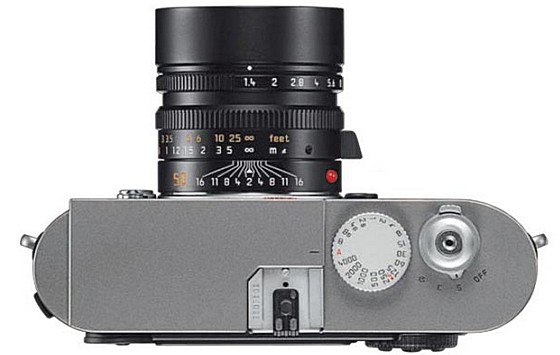
Flash exposure control
Flash unit connection
Via accessory shoe with center and control contacts.
Synchronization
Optional synchronization on first or second shutter curtain.
Flash sync speed
= 1/180 s; longer shutter speeds possible.
Flash exposure metering
(with SCA-3501/3502 adapter or SCA-3000 standard flash unit, e.g. Leica SF 24D/Leica SF 58). Control with centerweighted TTL-pre-flash metering.
Flash measurement cell
2 silicon photo diodes with condensing lens in camera base.
Flash exposure compensation
±3 1/3 EV in 1/3 EV steps adjustable on the SCA-3501/3502 adapter. On Leica SF 24D, ±3 EV in 1/3 EV- steps with computer control, or from 0 to –3 EV in 1 EV-steps/on Leica SF 58 adjustable in all modes ±3 EV in 1/3 EV-steps.
Displays in flash mode
Flash readiness: flash symbol LED in viewfinder constant. Correct flash exposure: LED constant or flashes rapidly after exposure. Underexposure: LED extinguished after exposure.
Viewfinder
Viewfinder principle
Large, bright-line frame viewfinder with automatic parallax compensation.
Eyepiece
Adjusted to -0.5 dpt. Correction lenses from -3 to +3 dpt. available.
Image framing
By activating two bright-line frames: For 35 and 135 mm, 28 and 90 mm, or for 50 and 75 mm. Automatic activation when lens is attached. Any pair of bright-line frames can be activated using the image field selector.
Parallax compensation
The horizontal and vertical difference between the viewfinder and the lens is automatically compensated according to the relevant distance setting, i.e. the viewfinder bright-line automatically aligns with the subject detail recorded by the lens.
Matching of viewfinder and actual picture
The size of the bright-line frame corresponds exactly to the sensor size of approx. 23.9 x 35.8 mm at a setting distance of 1 meter. At infinity setting, depending on the focal length, approx. 7.3 % (28 mm) to 18 % (135 mm) more is recorded by the sensor than indicated by the corresponding bright-line frame and slightly less for distances shorter than 1m.
Enlargement
(for all lenses) 0.68x.
Large basis rangefinder
Split or superimposed image range finder shown as a bright field in the center of the viewfinder image.
Effective rangefinderbase
47.1 mm (actual rangefinder base 69.25 mm x viewfinder enlargement 0.68x).
Displays
Viewfinder
(lower edge) LED symbol for flash status. Four-digit seven-segment digital display with dots above and below, display brightness adjusted for ambient brightness, for: Warning of exposure compensation, display for automatically generated shutter speeds in aperture priority mode, indication of use of metering memory lock, warning that the metering or setting ranges are over- or underexposed using aperture priority and counting down exposures longer than 2s.
LED light balance with two triangular and one central circular LED for manual exposure setting. The triangular LEDs give the direction of rotation of the aperture setting ring and shutter speed setting dial to adjust the exposure. Also as warning for over- or underexposure.
On rear panel
2,5” monitor (color TFT LCD) with 230,000 pixels.
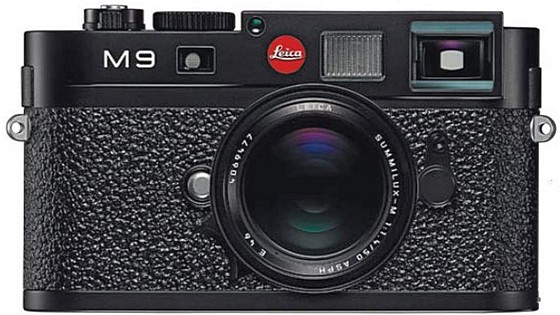
Shutter and release
Shutter
Microprocessor-controlled, exceptionally low-noise metal blade shutter with vertical movement.
Shutter speeds
For aperture priority (A) continuously adjustable from 32 s to 1/4000 s. For manual setting 8 s to 1/4000 s in half steps, B for long exposures of any duration (in conjunction with self timer T function, i. e. 1st release = shutter opens, 2nd release = shutter closes), (1/180 s) fastest shutter speed for flash synchronization.
Shutter cocking
Using low-noise integral motor, optionally after releasing the shutter release button.
Series exposures
Approx. 2 pictures/s, = 8 pictures in series.
Shutter release
Three levels: Exposure metering on – Metering memory lock (in aperture priority mode) – Shutter release. Integrated standard cable release thread.
Self timer
Delay optionally 2 (aperture priority and manual exposure setting) or 12 s (menu setting), indicated by flashing LED on front of camera and corresponding display on the monitor.
Switching the camera on/off
Using the main switch on the camera’s top panel, selectable automatic power-off for camera electronics after about 2/5/10 minutes, reactivation by pressing the shutter release button.
Power supply
1 lithium ion battery, nominal voltage 3.7 V, capacity 1900 mAh. Capacity display in monitor, when shutter held open (for sensor cleaning) additional acoustic warning when capacity is low.
Charger
Inputs: 100–240 V AC, 50/60Hz, automatic switching, or 12/24 V DC; Output: 4.2V DC, 800 mA.
Camera housing
Material
All-metal die cast magnesium body, KTL dip painted, synthetic leather covering. Top deck and baseplate in brass, black, or steel-grey paint finish.
Image field selector
Allows the bright-line pairs to be manually displayed at any time (e. g. for framing comparisons).
Tripod thread
Stainless steel, A 1/4 (1/4’’) DIN, in baseplate.
Operating conditions
0 to +40°C
Interface
5-pin mini-USB 2.0 High-Speed socket for fast data transfer.
Dimensions
(Width x Depth x Height) approx. 139 x 37 x 80 mm (5 1/2 x 11/2 x 3 1/6 in.).
Weight
585 g (19.8 oz) (with battery).
